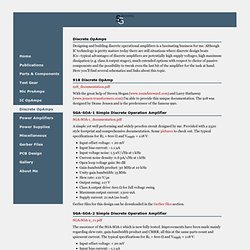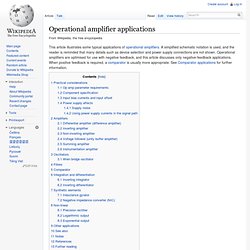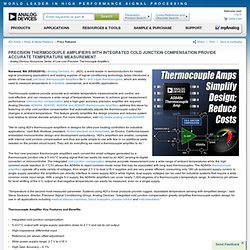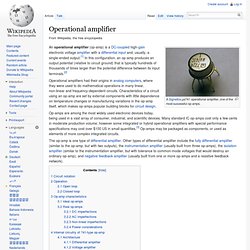

The Instrumentation Amplifier Handbook (PDF 116p) Download free online e-book chm pdf. Samuel Groner · Discrete OpAmps. Designing and building discrete operational amplifiers is a fascinating business for me.

Although IC technology is pretty mature today there are still situations where discrete design beats ICs—typical advantages of discrete amplifiers are potentially high supply voltages, high maximum dissipation (e.g. class A output stages), much extended options with respect to choice of passive components and the possibility to tweak even the last bit of the amplifier for the task at hand. Here you’ll find several schematics and links about this topic. 918_documentation.pdf With the great help of Steven Hogan (www.soundsteward.com) and Larry Hathaway (www.jensen-transformers.com) I’m able to provide this unique documentation. The 918 was designed by Deane Jensen and is the predecessor of the famous 990. Avedis Audio 1122 Discrete Op-Amp: Professional Audio Electronics Op Amp, Vintage Pro Audio OpAmp, Amplifier. Operational Amplifiers. Operational Amplifiers Operational amplifiers (op amps) were originally used for mathematical operations in 'analog' computers.

They typically have 2 inputs, a positive (non_inverting) input and a negative (inverting) input. A signal fed into the positive (non_inverting) input will produce an output signal which is in phase with the input. If the signal is fed into the negative (inverting) input, the output will be 180 degrees out of phase when compared to the input. The OP-AMP. Before we describe anything technical, let's see one in action.

Operational amplifier applications. This article illustrates some typical applications of operational amplifiers.

A simplified schematic notation is used, and the reader is reminded that many details such as device selection and power supply connections are not shown. Operational amplifiers are optimised for use with negative feedback, and this article discusses only negative-feedback applications. When positive feedback is required, a comparator is usually more appropriate. See Comparator applications for further information. Thermocouple sensor tutorial. Precision Thermocouple Amplifiers with Integrated Cold junction Compensation Provide Accurate Temperature Measurement. - Analog Devices Announces Series of Low-cost Precision Thermocouple Amplifiers.

Norwood, MA (05/26/2010) - Analog Devices, Inc. (ADI), a world leader in semiconductors for mixed-signal processing applications and leading supplier of signal conditioning technology, today introduced a series of low-cost, precision thermocouple amplifiers for K- and J-type thermocouples, which are widely used to measure temperature in industrial, commercial, and scientific applications.
Thermocouple systems provide accurate and reliable temperature measurements and control, are cost-effective, and can measure a wide range of temperatures. However, to achieve good measurement performance cold junction compensation and a high gain accuracy precision amplifier are required. Analog Devices’ AD8494, AD8495, AD8496 and AD8497 thermocouple amplifiers address this issue by featuring on-chip cold junction compensation that automatically adjusts the thermocouple output for changes in ambient temperature.
Discrete Op Amp Designs. The basis of the entire Tonelux designs centers around our two new discrete op-amps, the TX-240 and the TX-260.

Why did we call them that? Who knows. In designing the TX-240 op-amp, I came across some very interesting things. The op-amp sounded better without a power output stage, plus it required quite a bit less internal compensation for stability. Of course, this raises the problem of how to drive a transformer. Starting with the TX-240 op-amp, I began with some parameters, such as overall open loop gain, output drive and bias. OVERALL OPEN LOOP GAIN My feeling is that most of the op-amps designed today have more gain than they really need. OUTPUT DRIVE For proper internal use and limited external use, I decided that being able to drive 60 ohms was plenty. BIAS We all know the terms CLASS A, CLASS AB, etc. CLASS B is a type bias where you use TWO devices, one for the positive going part of the wave form and one for the negative going wave form. Operational amplifier. A Signetics μa741 operational amplifier, one of the most successful op-amps.

Simple op-amp : DISCRETE SEMICONDUCTOR CIRCUITS. Two 6-volt batteriesFour NPN transistors -- models 2N2222 or 2N3403 recommended (Radio Shack catalog # 276-1617 is a package of fifteen NPN transistors ideal for this and other experiments)Two PNP transistors -- models 2N2907 or 2N3906 recommended (Radio Shack catalog # 276-1604 is a package of fifteen PNP transistors ideal for this and other experiments)Two 10 kΩ potentiometers, single-turn, linear taper (Radio Shack catalog # 271-1715)One 270 kΩ resistorThree 100 kΩ resistorsOne 10 kΩ resistor Lessons In Electric Circuits, Volume 3, chapter 4: "Bipolar Junction Transistors" Lessons In Electric Circuits, Volume 3, chapter 8: "Operational Amplifiers" Design of a differential amplifier circuit using current mirrors.Effects of negative feedback on a high-gain differential amplifier.
This circuit design improves on the differential amplifier shown previously. Measure the output voltage (voltage at the collector of Q4 with respect to ground) as the input voltages are varied. Related Links.